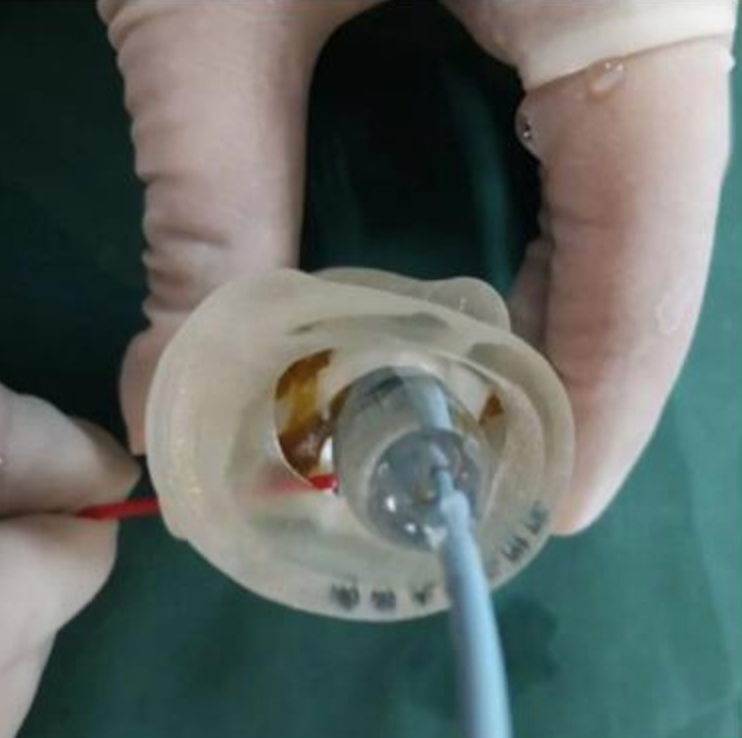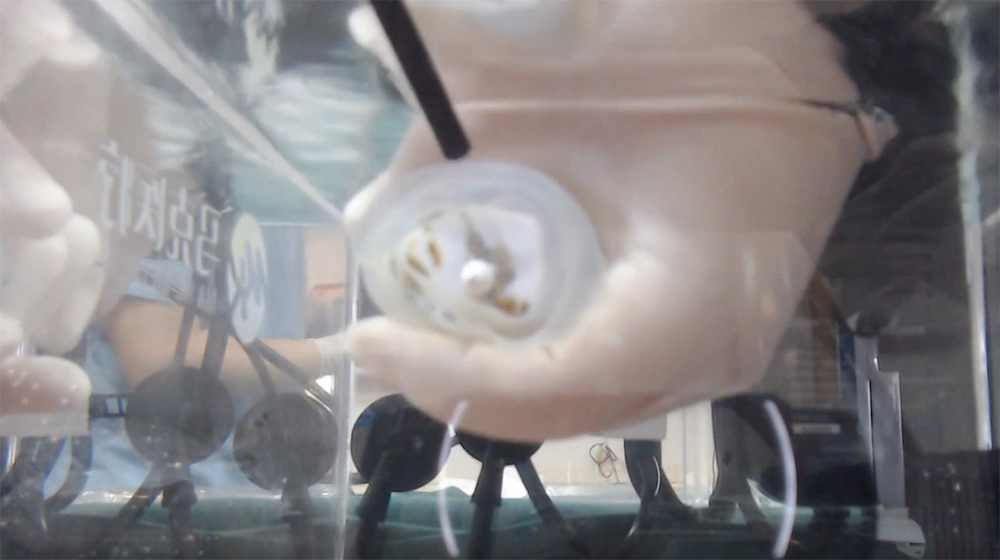


上个月,华东地区南昌市的医生首次使用3D打印技术来协助复杂的心血管手术。在概述最终计划之前,位于中国江西省南昌大学第二附属医院的术前评估团队依靠3D打印来模拟高危重症高危老年患者的经导管主动脉瓣置换术(TAVR)主动脉瓣狭窄。使用3D打印进行体外实验模拟,他们能够评估与手术相关的风险。成功的手术使他们意识到3D打印技术可以帮助其他医师为其患者设计更多个性化的治疗方案。
Last month, doctors in east China’s Nanchang city used 3D printing technology for the first time to assist a complex cardiovascular surgery. Before outlining their final plan, a pre-operative evaluation team at the Second Affiliated Hospital of Nanchang University, in China’s Jiangxi Province, relied on 3D printing to simulate a transcatheter aortic valve replacement (TAVR) surgery on a high-risk elderly patient with severe aortic valve stenosis. Using 3D printing to conduct in vitro experimental simulations they were able to assess the risks related to the surgery. The successful operation led them to acknowledge that 3D printing technology could help other physicians design more personalized treatment solutions for their patients.
主动脉瓣狭窄是一种常见的临床心脏病,当心脏的主动脉瓣无法完全打开而阻止血液的正常流动时,会发生高发病率和高死亡率。一旦出现症状,如果不进行手术治疗,死亡率将很高,一年和五年生存率分别为52%和22%。它是老年人最常见的瓣膜性心脏病,并随着年龄的增长而增加。在中国,超过75岁的患者中度或重度主动脉瓣狭窄的患病率超过2%。
Aortic valve stenosis is a common clinical heart disease with high morbidity and mortality occurring when the aortic valve of the heart fails to open completely, preventing the normal flow of blood. Once symptoms appear, if surgical treatment is not performed, the mortality rate is very high, with one-year and five-year survival rates at 52% and 22%, respectively. It is the most common valvular heart disease of the elderly and increases with age. In China, the prevalence of moderate or severe aortic stenosis in patients more than 75 years old is over two percent.
根据第二附属医院的报道,为治疗该疾病,外科医生通常进行开胸主动脉瓣置换术,但是对于老年人和患有其他严重基础疾病的人,手术风险远大于疾病本身的风险。相反,外科医生倾向于选择TAVR瓣膜置换手术,因为它具有微创性,不需要体外循环并且术后恢复率很高。然而,许多并发症仍然困扰着该手术,例如瓣环破裂,急性冠状动脉开放性阻塞和瓣周漏。
As reported by the Second Affiliated Hospital, to treat the condition, surgeons usually perform a thoracotomy aortic valve replacement, but for the elderly and people with other serious underlying diseases, the surgical risk is much greater than the risk of the disease itself. Instead, surgeons tend to choose TAVR valve replacement surgery because it is minimally invasive, does not require extracorporeal circulation, and has a high rate of post-surgery recovery. Nevertheless, many complications still plague this procedure, such as annulus rupture, acute coronary opening obstruction, and paravalvular leakage.
中国外科医生断言,在TAVR手术中,他们不能直接看整个主动脉根,也不能切开心脏来观察内部解剖结构。因此,为准备手术,他们通常仅依靠计算机断层扫描(CT)扫描,磁共振成像(MRI)和心脏超声检查,这些检查只能为他们提供患者的二维图像和非常有限的视野。
The Chinese surgeons asserted that during the TAVR operation, they cannot directly look at the entire aortic root, nor can they cut the heart to observe the internal anatomical structure. So, to prepare for the surgery, they usually solely rely on computerized tomography (CT) scans, magnetic resonance imaging (MRI), and cardiac ultrasounds that only provide them with a two-dimensional image of the patient and a very limited field of vision.

金星A瓣膜用于术前TAVR手术的3D模型重建(来源:南昌大学第二附属医院)
3D model reconstruction for preoperative TAVR surgery using a Venus A valve (Credit: Second Affiliated Hospital at Nanchang University)
与传统的计划相比,通过将患者的二维图像平面数据转换为1:1全尺寸模型,外科医生可以用来可视化和标准化非常复杂的程序,事实证明3D打印技术在术前准备中非常有用。越来越多的证据表明,这些3D打印的模型通过减少手术时间来提高患者的安全性和准确性。
Compared to traditional planning, 3D printing technology has proven extremely useful in presurgical preparations, by converting the patient’s two-dimensional image plane data into a 1:1 full- size model that surgeons can use to visualize and standardize a very complex procedure. There is growing evidence that these 3D-printed models improve patient safety and accuracy by decreasing operative times.
在第二附属医院心血管内科主任吴彦清的领导下,术前评估小组决定在确定手术策略之前首先进行体外实验模拟以评估患者在手术过程中的风险。
Under the leadership of Yanqing Wu, director of the Department of Cardiovascular Medicine at the Second Affiliated Hospital, a pre-operative evaluation team decided to first conduct in vitro experimental simulations to assess the patient’s risks during surgery before determining the operation strategy.

体外TAVR手术模拟实验(来源:南昌大学第二附属医院)
In vitro TAVR surgery simulation experiment (Credit: Second Affiliated Hospital at Nanchang University)
这位73岁的男性患者给外科医生带来了真正的挑战。他的医生发现了STS分数为中高风险,这是胸外科协会分数的缩写,这是一种基于STS全国成人心脏外科手术数据库中数据的经验证的开放手术风险预测模型。此外,患者的术前CT扫描提示双叶主动脉瓣,严重钙化和冠状动脉闭塞的高风险。基于所有这些考虑,理想的是3D打印的术前方法。
The 73-year-old male patient presented a real challenge for surgeons. His physicians had detected a mid- to high-risk STS score, short for Society of Thoracic Surgery score, a validated risk-prediction model for open surgery based on data from the STS National Adult Cardiac Surgery Database. Additionally, preoperative CT scans from the patient suggested a bilobal aortic valve, severe calcification, and a high risk of coronary occlusion. Based on all these considerations, a 3D-printed presurgical approach was ideal.
有效地,3D重建和打印的真实图像都证实了钙化病变正在加重对左心室流出道的阻塞。然后,研究小组使用来自中国医疗设备领导者Venus Medtech的23毫米气球进行预扩张和26毫米TAVR Venus-A瓣膜植入物进行了体外模拟实验。
Effectively, both the 3D reconstruction and the printed real images confirmed that the calcified lesions were worsening obstruction to the left ventricular outflow. The team then conducted an in vitro simulation experiment, using a 23-millimeter balloon for predilatation and a 26-millimeter TAVR Venus-A valve implant, from Venus Medtech (a China-based leader in medical devices).
实验结果证实,在植入瓣膜后,冠状动脉的左开口未受到任何影响。此外,体外TAVR手术模拟实验的结果证明可预测,足以继续进行患者手术。最后,在各个专业团队的合作下,患者的TAVR操作成功完成。
The experimental results confirmed that after the valve was implanted, the left coronary artery opening was not affected in any way. Moreover, the results of the in vitro TAVR surgery simulation experiments proved predictable enough to move on to the patient surgery. Finally, with the cooperation of various professional teams, the patient’s TAVR operation was successfully completed.

外科医生使用3D打印模型模拟TAVR手术(来源:南昌大学第二附属医院)
Surgeons simulate the TAVR surgery using a 3D printed model (Credit: Second Affiliated Hospital at Nanchang University)
最新的PARTNER 3系列随机对照试验显示,在低危患者中,TAVR可以在一年内减少死亡,中风或再次住院,优于主动脉瓣狭窄的另一种常规外科治疗方法,即外科主动脉瓣置换术(SAVR)。尽管如此,并非所有的主动脉瓣狭窄患者都是低危患者,实际上,在南昌大学医院接受治疗的患者被认为是高危患者。此外,医院专家认为,一般而言,患者应在手术前进行更彻底的评估,以真正获得精确和个性化的药物。
The latest PARTNER 3 series of randomized controlled trials showed that in low-risk patients, TAVR was superior to another conventional surgical treatment of aortic valve stenosis known as surgical aortic valve replacement (SAVR) at reducing death, stroke, or rehospitalization at one year. Nonetheless, not all aortic stenosis patients are low-risk, in fact, the patient treated in Nanchang University’s hospital was deemed high-risk. Moreover, the experts at the hospital considered that patients, in general, should undergo a more thorough evaluation before surgery to truly achieve precision and individualized medicine.
这与基于单方面知识的传统治疗模型截然不同。实际上,这个基于术前3D打印技术的TAVR手术示例需要心血管医学,影像专家和心脏外科医生进行有效的协作才能取得成功的结果。
This is a very different approach from the traditional treatment models based on unilateral know-how. In fact, this example of TAVR surgery based on presurgical 3D printing technology required effective teamwork in cardiovascular medicine, imaging experts, and cardiac surgeons to achieve successful results.
医院声称,各个专业领域和技术的共同努力可以帮助设计针对不同患者的高度个性化的治疗计划,从而最大程度地提高他们的安全性。这就是为什么第二附属医院的TAVR团队期望在江西省领导未来使用3D打印技术的TAVR手术,以实现更全面,更高质量的进步。
The hospital claims that the joint efforts of various professional disciplines and technology can help design highly personalized treatment plans for different patients, maximizing their safety. This is why the TAVR team of the Second Affiliated Hospital expects to lead future TAVR surgeries using 3D printing technology in the Jiangxi province to achieve more comprehensive and higher-quality progress.
文章来源:3dprint